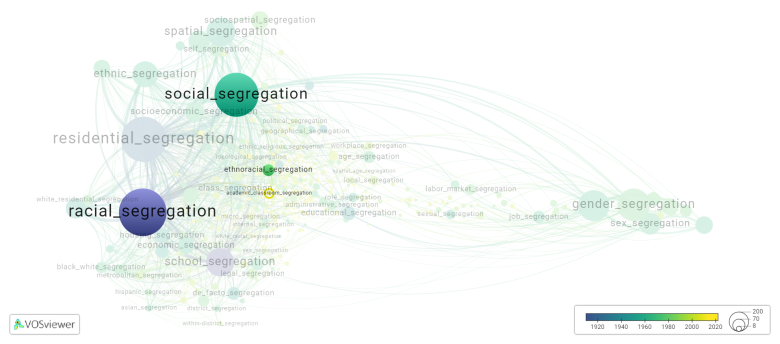Academic classroom segregation: Difference between revisions
(Creating page) |
(Creating page) |
||
| (7 intermediate revisions by the same user not shown) | |||
| Line 1: | Line 1: | ||
===== Date and country of first publication<ref>Date and country of first publication as informed by the Scopus database (December 2023).</ref>===== | |||
2020<br> | 2020<br> | ||
United States | United States | ||
===== Definition ===== | |||
Academic classroom segregation refers to the practice of separating students based on their academic abilities, typically resulting in students of lower academic achievement being placed in lower-level or remedial classes, while higher achieving students are placed in advanced or honors classes. This practice can create a divide among students, leading to unequal opportunities and resources for academic success. Academic classroom segregation can also perpetuate stereotypes and limit the potential for growth and development for students who are placed in lower-level classes. Efforts to address academic classroom segregation include providing equal access to resources and opportunities for all students, implementing inclusive teaching practices, and promoting diversity and equity in education. | Academic classroom segregation refers to the practice of separating students based on their academic abilities, typically resulting in students of lower academic achievement being placed in lower-level or remedial classes, while higher achieving students are placed in advanced or honors classes. This practice can create a divide among students, leading to unequal opportunities and resources for academic success. Academic classroom segregation can also perpetuate stereotypes and limit the potential for growth and development for students who are placed in lower-level classes. Efforts to address academic classroom segregation include providing equal access to resources and opportunities for all students, implementing inclusive teaching practices, and promoting diversity and equity in education. | ||
==See also== | ==See also== | ||
==Related segregation forms== | |||
Academic classroom segregation is frequently discussed in the literature with the following segregation forms: | |||
[[racial segregation]], [[social segregation]], [[ethnoracial segregation]] | |||
[[File:academic_classroom_segregation.png|780x780px]] | |||
This visualization is based on the study [[Segregation_Wiki:About| The Multidisciplinary Landscape of Segregation Research]]. | |||
For the complete network of interrelated segregation forms, please refer to: | |||
* [https://tinyurl.com/2235lkhw First year of publication] | |||
* [https://tinyurl.com/2d8wg5n3 Louvain clusters] | |||
* [https://tinyurl.com/223udk5r Betweenness centrality] | |||
* [https://tinyurl.com/244d8unz Disciplines in which segregation forms first emerged (Scopus database).] | |||
==References== | ==References== | ||
==Notes== | ==Notes== | ||
<references /> | <references /> | ||
{{NoteAI}} | {{NoteAI}} | ||
== | ==Academic classroom segregation appears in the following literature== | ||
Kogachi K. | Kogachi K., Graham S. (202). Numerical Minority Status in Middle School and Racial/Ethnic Segregation in Academic Classes. ''Child Development'', ''91''(6), 2083-2102. Blackwell Publishing Inc..https://doi.org/10.1111/cdev.13408 | ||
Latest revision as of 07:17, 16 October 2024
Date and country of first publication[1][edit | edit source]
2020
United States
Definition[edit | edit source]
Academic classroom segregation refers to the practice of separating students based on their academic abilities, typically resulting in students of lower academic achievement being placed in lower-level or remedial classes, while higher achieving students are placed in advanced or honors classes. This practice can create a divide among students, leading to unequal opportunities and resources for academic success. Academic classroom segregation can also perpetuate stereotypes and limit the potential for growth and development for students who are placed in lower-level classes. Efforts to address academic classroom segregation include providing equal access to resources and opportunities for all students, implementing inclusive teaching practices, and promoting diversity and equity in education.
See also[edit | edit source]
Related segregation forms[edit | edit source]
Academic classroom segregation is frequently discussed in the literature with the following segregation forms:
racial segregation, social segregation, ethnoracial segregation

This visualization is based on the study The Multidisciplinary Landscape of Segregation Research.
For the complete network of interrelated segregation forms, please refer to:
References[edit | edit source]
Notes[edit | edit source]
- ↑ Date and country of first publication as informed by the Scopus database (December 2023).
At its current state, this definition has been generated by a Large Language Model (LLM) so far without review by an independent researcher or a member of the curating team of segregation experts that keep the Segregation Wiki online. While we strive for accuracy, we cannot guarantee its reliability, completeness and timeliness. Please use this content with caution and verify information as needed. Also, feel free to improve on the definition as you see fit, including the use of references and other informational resources. We value your input in enhancing the quality and accuracy of the definitions of segregation forms collectively offered in the Segregation Wiki ©.
Academic classroom segregation appears in the following literature[edit | edit source]
Kogachi K., Graham S. (202). Numerical Minority Status in Middle School and Racial/Ethnic Segregation in Academic Classes. Child Development, 91(6), 2083-2102. Blackwell Publishing Inc..https://doi.org/10.1111/cdev.13408
